Must-know wedding customs in Vietnam
Vietnam is a country of rich traditions, and its wedding customs in Vietnam are no exception. With 54 ethnic groups and diverse regional influences, Vietnamese weddings vary from North to South, each with its own unique rituals and symbolism. This article explores the most common and fascinating wedding customs in Vietnam, helping you understand their cultural significance.
The importance of wedding customs in Vietnam
In Vietnamese culture, weddings are not just personal celebrations but also significant family and social events. A wedding represents the official union of two individuals and the bonding of two families, reinforcing values of respect, harmony, and tradition. Despite modern influences, many Vietnamese families still follow traditional wedding customs. These rituals help preserve cultural identity and strengthen family bonds. While some customs have evolved to suit contemporary lifestyles, the core values of wedding traditions in Vietnam remain, keeping the connection between past and present alive.
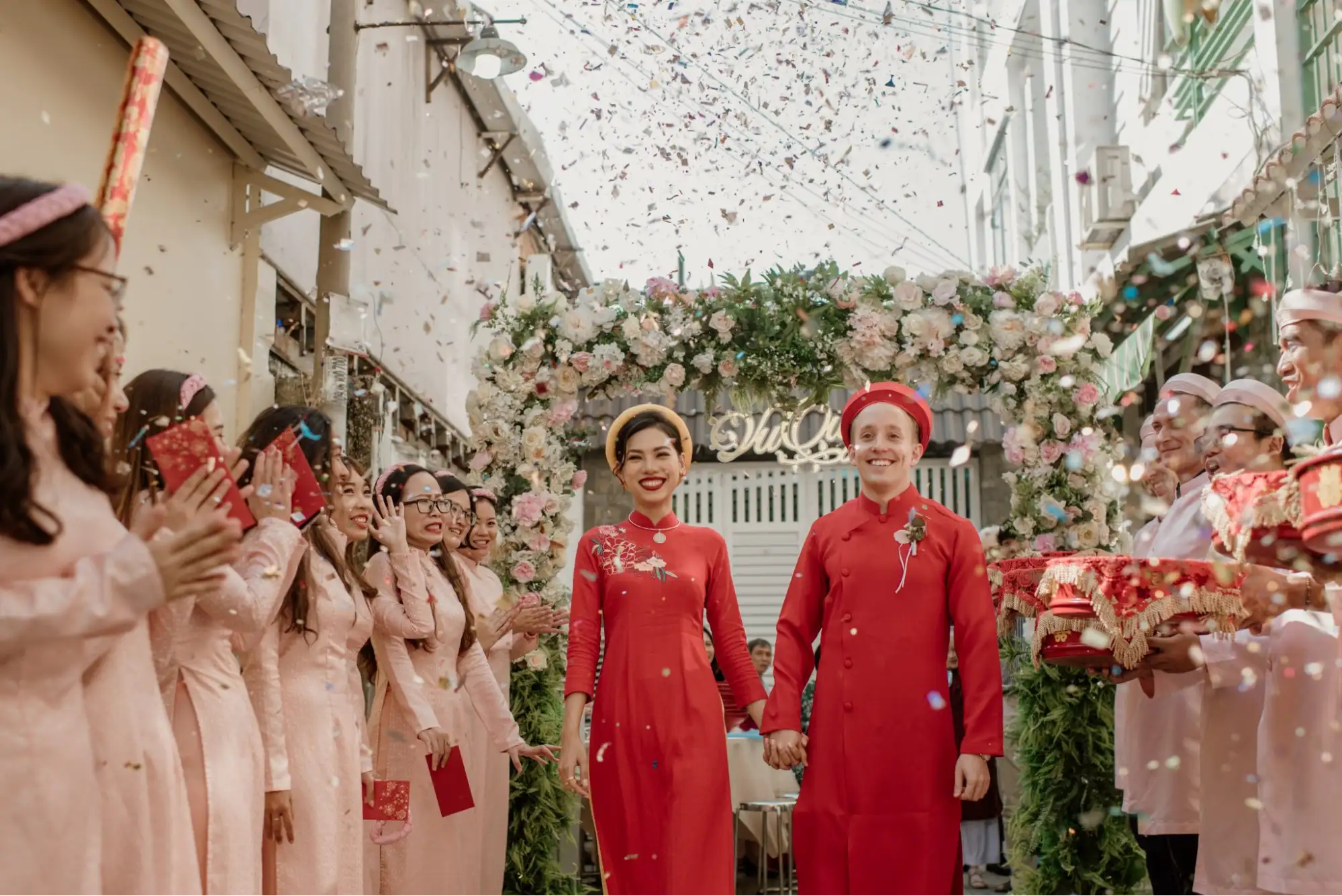
Essential rituals in a traditional Vietnamese wedding
Wedding customs in Vietnam is quite complicated. Weddings follow a structured sequence of rituals, each with its own cultural and spiritual significance. Despite regional variations, the essential ceremonies remain a cherished part of wedding customs in Vietnam, connecting families and generations.
Le Dam Ngo – the first step in a traditional Vietnamese wedding
Le Dam Ngo is the first step in a traditional Vietnamese wedding, marking the official introduction between the two families. It is a meaningful occasion where both sides formally acknowledge the relationship and express their respect for each other.
In this ceremony, the groom’s family visits the bride’s home with symbolic gifts such as betel leaves, areca nuts, tea, wine, and sweets—wishing for a harmonious union. A representative from the groom’s side expresses their intent for marriage, while the bride’s family welcomes the proposal. Some families also offer incense at the ancestral altar to inform their ancestors.
After the formalities, both families share a warm meal, strengthening their bond. While modern weddings may simplify this tradition, Le Dam Ngo remains an essential part of wedding customs in Vietnam, preserving cultural values and family connections.
Le An Hoi – the official engagement ceremony
As one of the most significant wedding customs in Vietnam, Le An Hoi marks the official engagement between a couple, signifying their families’ approval and commitment to the marriage. This ceremony is deeply rooted in Vietnamese culture, emphasizing respect, tradition, and the union of two families.
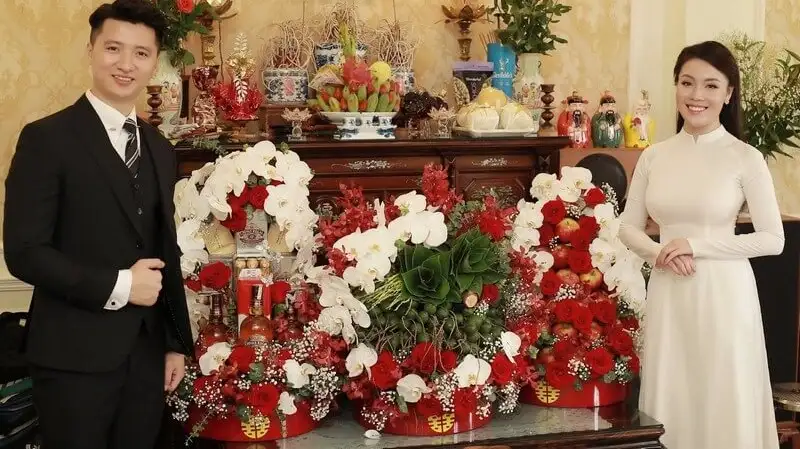
During the engagement ceremony, the groom’s family visits the bride’s home, bringing carefully arranged trays of offerings. These gifts typically include betel leaves, areca nuts, tea, wine, cakes, and jewelry, all symbolizing prosperity, good fortune, and harmony. The items are carried in a formal procession by male relatives and friends, highlighting the importance of the occasion.
Upon arrival, both families exchange greetings, and a representative from the groom’s side formally requests permission for the marriage. The bride’s family accepts the proposal by receiving the gifts, and the groom places an engagement ring on the bride’s finger, sealing their commitment. In many cases, an incense ceremony is performed at the bride’s ancestral altar to seek blessings for a happy and prosperous future.
Following the rituals, both families gather for a celebratory meal, strengthening their bond and marking the joyful occasion. While modern weddings may simplify certain traditions, Le An Hoi remains a cherished part of wedding customs in Vietnam, reflecting the deep cultural values of respect, family, and unity.
Le Cuoi – the traditional wedding ceremony
The traditional wedding ceremony in Vietnam, or Le Cuoi, is the most important event in a traditional Vietnamese wedding. It marks the official union of the bride and groom, witnessed by their families and loved ones. This ceremony is rich in rituals and symbolizes respect for ancestors, family values, and the beginning of a new life together.

On the wedding day, the groom’s family arrives at the bride’s house in a formal procession. They bring wedding gifts similar to those in Le An Hoi, but often more elaborate. The bride, dressed in a traditional ao dai, waits inside with her family. The groom formally asks for permission to take the bride to his home, and a representative from the bride’s family delivers a response.
One of the most significant rituals is the ancestral altar ceremony. The couple, guided by their parents, offers incense and bows before the ancestors, seeking blessings for a happy and prosperous marriage. This ritual reflects the deep respect for family heritage in wedding in Vietnam.
After the rituals at the bride’s house, the groom escorts the bride to his family’s home. Traditionally, the bride must step over a small brazier at the entrance, symbolizing the removal of bad luck and the welcoming of new happiness.
At the groom’s house, another ancestral ceremony takes place to introduce the bride to the new family. This act officially recognizes her as a new member, reinforcing the importance of family ties in Vietnamese culture.
The wedding banquet is a grand celebration where both families, friends, and guests gather to share the couple’s happiness. It is usually held at a restaurant or banquet hall, featuring speeches, toasts, music, and performances. The couple goes around to thank guests, receiving their blessings and gifts.
While modern weddings have introduced some Western influences, Le Cuoi remains a deeply cherished tradition in wedding customs in Vietnam, symbolizing love, respect, and the connection between two families.
Le Lai Mat – the post-wedding visit
Le Lai Mat is the final step in a traditional Vietnamese wedding, symbolizing the bride’s return to her family after marriage. This ceremony, usually held a few days after the wedding, reinforces the bond between the two families and ensures the bride’s smooth transition into her new life.

In Vietnamese culture, marriage is not just about the couple but also about the unity of their families. Le Lai Mat is a way for the bride’s family to check on her well-being and for the groom to show respect to his in-laws. It signifies the continued connection between the bride and her birth family, even after she moves to her husband’s home.
A few days after the wedding, the newlyweds visit the bride’s parents, bringing simple gifts like tea, fruits, or traditional cakes. This gesture expresses gratitude to the bride’s family for raising her and entrusting her to the groom. The visit is also an opportunity for the bride to share her experiences in her new home.
During the visit, the bride’s parents offer advice on marriage life and remind her to maintain strong family values. In some families, a small meal is prepared to welcome the couple, strengthening the bond between both sides. In modern weddings, Le Lai Mat is sometimes skipped or simplified, especially if the couple lives far from the bride’s family.
Other unique wedding customs in Vietnam
Beyond the main wedding ceremonies, Vietnam has a rich collection of unique customs that reflect its deep-rooted cultural values. These traditions, passed down through generations, emphasize respect for ancestors, the importance of family, and the pursuit of harmony and good fortune.
Choosing an auspicious wedding date
In wedding customs in Vietnam, selecting a favorable wedding date is a crucial step, believed to bring happiness, harmony, and prosperity to the couple’s married life. This practice reflects the deep influence of spiritual beliefs and astrology in Vietnamese culture.
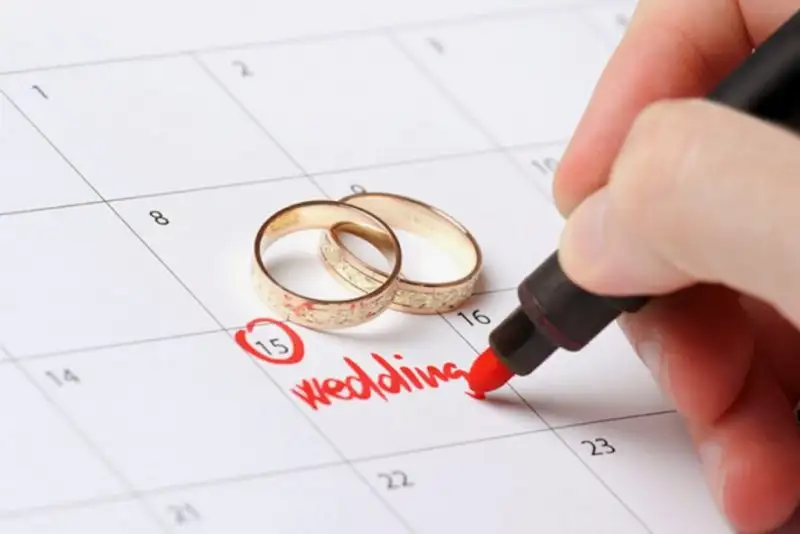
Vietnamese people believe that a well-chosen wedding date can affect the couple’s future, bringing them happiness, longevity, and wealth. This tradition highlights the importance of fate and harmony in a successful marriage. Before setting a wedding date, families often consult a fortune teller or a monk who analyzes the couple’s birthdates and zodiac signs. Based on these factors, an auspicious day and time are chosen to ensure a smooth and blessed marriage. The date should avoid conflicting with bad omens or unlucky lunar calendar days.
While some modern couples may prioritize personal schedules over traditional beliefs, many still follow this custom out of respect for their families. Even if they do not strictly follow fortune-telling, they often choose wedding dates based on family advice and cultural traditions.
Choosing the good hour for the bridge’s procession
The timing of the bride’s procession to the groom’s house is carefully chosen based on astrology and feng shui. This tradition is believed to ensure a smooth transition for the bride, bringing happiness and prosperity to the couple’s future.
Families often consult a fortune teller or monk to determine the most auspicious hour, considering factors such as the lunar calendar, the couple’s birth dates, and zodiac signs. The selected time is usually early in the morning or before noon, avoiding bad omens or unlucky hours. On the wedding day, the groom’s family arrives at the bride’s house precisely at the chosen hour to escort her to her new home. The timing is strictly followed, as any delay is thought to bring misfortune.
The Ede tradition of proposing to the groom
In contrast to the common Vietnamese custom where the groom’s family proposes marriage, the Ede people follow a matrilineal tradition in which the bride’s family takes the initiative. In this unique practice, the bride’s family sends a matchmaker to the groom’s house to formally ask for his hand in marriage. This proposal signifies the beginning of wedding arrangements and reflects the Ede’s strong matriarchal system.
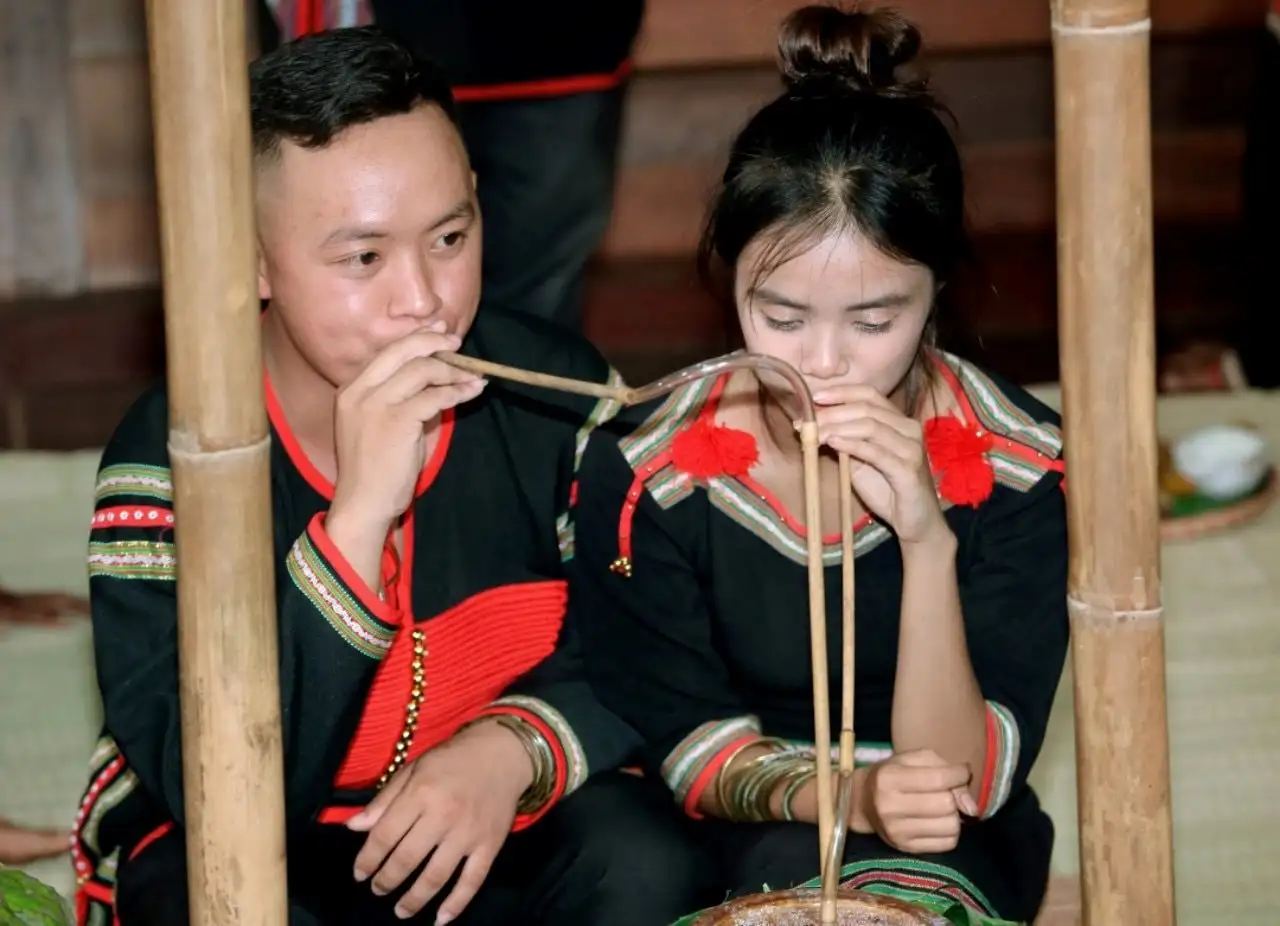
Once the proposal is accepted, the bride’s family prepares for the wedding and covers all expenses. After marriage, the groom moves into the bride’s family home, becoming a part of her lineage. Their children inherit the mother’s surname, ensuring the continuity of the family’s heritage.
This tradition, deeply rooted in Ede culture, highlights the diversity of wedding customs in Vietnam and showcases the rich cultural identity of Vietnam’s ethnic minorities.
Regional differences in wedding customs in Vietnam
Vietnam’s diverse geography and cultural heritage have shaped distinct wedding customs across different regions. While the core traditions remain similar, each region has unique rituals that reflect local beliefs and lifestyles.
In Northern Vietnam, weddings are often formal and deeply rooted in Confucian traditions. The engagement and wedding ceremonies follow strict etiquette, emphasizing respect for ancestors and family hierarchy. The bride’s procession to the groom’s house is carefully timed according to astrology, and traditional red and gold decorations symbolize prosperity and happiness.
In Central Vietnam, particularly in provinces like Hue, weddings are known for their elegance and simplicity. Influenced by royal traditions, the ceremonies often include tea and candle rituals to honor the couple’s ancestors. The bride’s áo dài (traditional dress) is usually embroidered with intricate patterns, reflecting the refined aesthetics of the region.
In Southern Vietnam, weddings tend to be more relaxed and festive. The ceremonies are less rigid, with a stronger emphasis on celebration and entertainment. Music, dance, and even modern wedding themes are more common, blending tradition with contemporary influences. Unlike the north, where formal speeches are essential, southern weddings focus more on joyful gatherings with family and friends.
Despite these regional differences, wedding customs in Vietnam share a common emphasis on family unity, respect for ancestors, and wishes for a prosperous married life. Whether in the north, central, or south, each wedding reflects the cultural identity of its people while adapting to modern influences.
Wedding customs in Vietnam in modern times
Vietnamese wedding customs have changed significantly due to modernization and global influences. While traditional rituals remain, many have been simplified to suit contemporary lifestyles.
Ceremonies that once spanned multiple days are now often shortened or combined to save time and costs. Western influences are also evident, with many couples opting for white gowns, suits, and hotel receptions while still incorporating traditional ao dai and ancestral rituals.
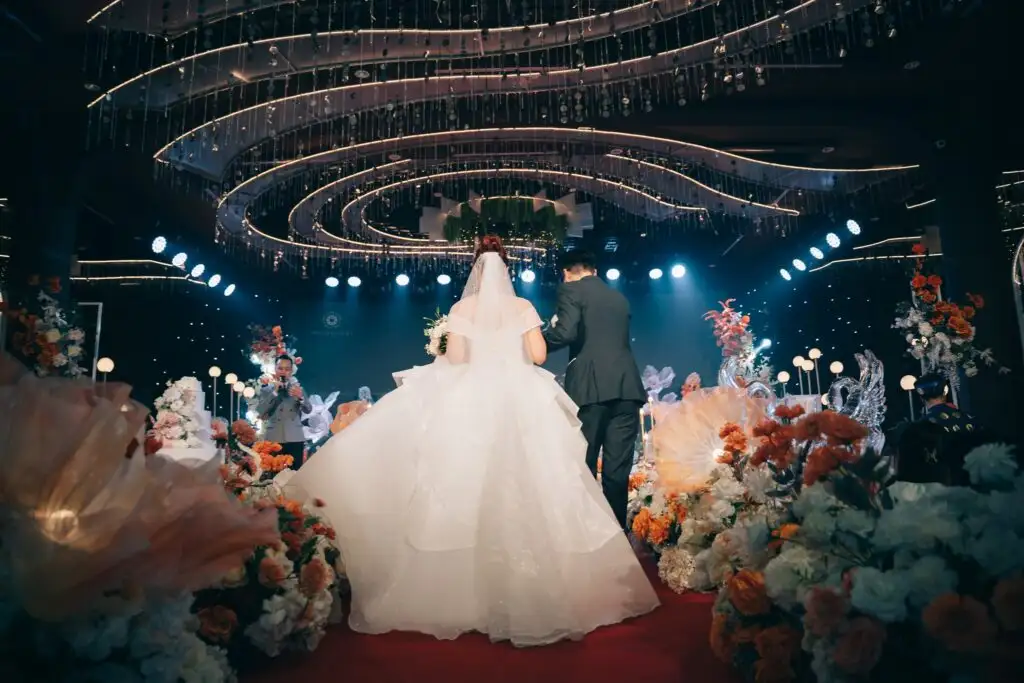
Family roles have shifted as well, marriages are now based on love rather than family arrangements, and couples have more control over planning and finances. Dowries, once a key part of negotiations, are becoming less important, especially in urban areas.
Despite these changes, core traditions like ancestor worship, tea ceremonies, and family unity remain deeply valued, ensuring that wedding customs in Vietnam continue to evolve while preserving their cultural essence.
Vietnamese wedding customs are a beautiful reflection of the country’s rich heritage, emphasizing family bonds, respect, and love. Understanding these wedding customs in Vietnam will enhance your appreciation of this meaningful occasion. To ensure your wedding respects these customs while offering a luxurious experience, consider Bliss Hoi An Resort. With world-class hospitality, breathtaking ocean views, and personalized wedding services, your big day will be as meaningful as it is magical.








